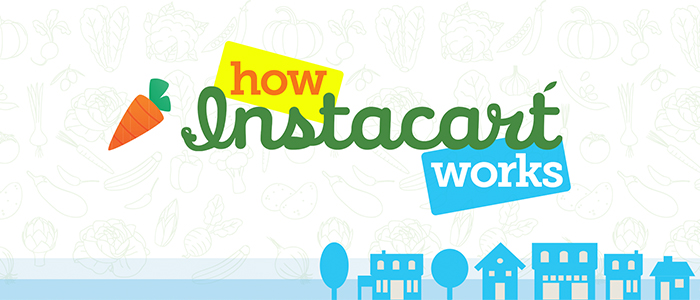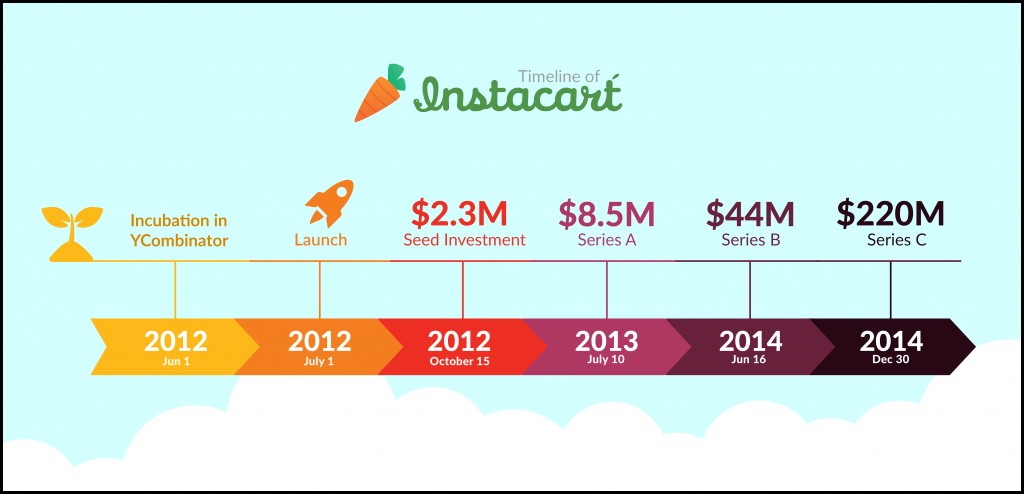
- Products
- Solutions
- Learn
- Partner
- Try Now

- What is Instacart?
- Founders, Funding received, Facts and Timeline
- Salient Features of Instacart
- Value Proposition
- Instacart’s 3 Customer Segments Explained
- Instacart Business Model Canvas
- How Instacart finds customers
- The process of Recruiting Shoppers
- Key Problems and Solutions
- Latest Updations
What is Instacart?
Instacart is an on-demand grocery delivery platform facilitating doorstep deliveries of groceries and other home essentials in major cities of the USA.
The technology-driven business model of Instacart boosts delivering groceries to customers in as little as 1 hour, making it one of the most promising and futuristic companies in the USA which is based on sharing economy model.
This grocery delivery startup has become so famous in the on-demand sector that a lot of budding entrepreneurs are interested to learn more about the Instacart business model and understand its overall work to develop the next big thing in the sharing economy.
This post from Juggernaut will show you how Instacart works and makes money along with some interesting facts and figures about this $2 billion valuation company.
Founders, Funding received, Facts and Timeline
It was founded in the year 2012 and is one of the most recent technology developments which has shaken the world with its business model. Being considered a leader in the on-demand economy, Instacart has received massive funding to expand its grocery delivery app operations all across the USA.
Here are few facts about Instacart:
- Founded by: Apoorva Mehta (CEO / Founder) and Max Mullen (Co-Founder)
- Funding received: $275 million (Till the mid of year 2015)
- Company Valuation: $2 Billion. (As per Jan 2015)
- Revenue: $100 million (As of Jan 2015).
- Headquarters: San Francisco, California, USA.
The following graphic will help you understand the quick growth of Instacart.

The amount of funding received by Instacart clearly shows the trust of investors in this start-up and its projected future. Furthermore, to understand what makes Instacart a promising company, let me quickly take you through the salient features and the value propositions of Instacart. Thereafter, we’ll move on to understand its core working and its customer segments.
Salient Features of Instacart:
- Available in major areas of the USA including SF Bay Area, San Jose, NYC, Brooklyn, Washington DC, Philadelphia, Boston, Chicago, Austin, Seattle and Los Angeles.
- A collection of over 300,000 items from several stores such as Whole Foods, Safeway or Costco enabling customers to place orders from their favourite store or to mix items from different stores into one order.
- Crowdsourced Marketplace model with users being connected to personal shoppers who shop for ordered items and deliver them to the customers.
Value Proposition:
- Tie-ups with existing supermarkets
- Willing part time workers and their cars
- Vast inventory
- Extremely quick grocery delivery services
- No warehouses
- No shiny delivery trucks
Instacart’s 3 Customer Segments Explained:
Users:
- They have an app from where they can order groceries by choosing one or more stores.
- They can even order from a desktop or laptop using a web based interface.
- Users pay online for their order and can tip their shopper in advance during check out.
- Option to shop from any of the available stores in their area.One can place order by combining items from different stores
- Users can schedule orders for a specific day and time.
Shoppers:
- Purchaser receive orders on their smartphones.
- Shoppers are stationed near the stores in order to save time.
- They pick up the ordered items manually and deliver it to the customer.
- Apart from the per hour pay, shoppers often get a tip from customers.
Stores:
- It has tie-ups with major superstores in various cities.
- These stores have been able to increase their revenue through online sales via Instacart.
Instacart Business Model Canvas
The 4 step model about How Instacart Works:
- A customer places his order for groceries and pays online to Instacart.
- A personal shopper receives the order and starts collecting items as mentioned in the order.
- Shopper pays the bill through Instacart’s prepaid debit card which is accepted at the grocery store.
- The shopper then goes to deliver the groceries to the customer as per the address mentioned in the order.
Any tip paid in cash at the real time of delivery directly goes to the shopper and the perks given to the shopper during checkout get accumulated in his Instacart account and are offered at the end of the week along with the salary.
Instacart revenue model – How it makes money?
- Delivery Fee
Moreover, every order processed by Instacart which is above the value of $35 attracts a standard delivery fee of $3.99 for a scheduled or 2-hour delivery and $5.99 for a 1-hour delivery.
However, the orders under $35 value are charged at $7.99 for a scheduled or 2-hour delivery and $9.99 for 1-hour delivery.
- Membership Fee (Instacart Express)
In addition, it also offers an annual membership by the name ‘Instacart Express’ priced at $99. Users with this membership can get free groceries for a full 1 year with a few terms and conditions.
- Mark up prices (15%+ more)
Some stores selling their products on it offer the same prices as their in-store prices but few of them listed on Instacart have a mark-up of 15%+more from it. Therefore revenue from these increased prices goes to Instacart which helps them pay the shoppers.
How Instacart finds customers?
- Word of Mouth Advertising
- Internet Marketing
- Free first delivery
- Various offers
The process of Recruiting Shoppers:
- Application are invited from individuals who want to earn money by shopping in their free time and work for Instacart.
- The applications are processed by the recruitment team and a face to face, one on one interview is scheduled.
- Proper training is provided to selected individuals before they are ready to shop and deliver groceries.
Key Problems and Solutions:
- Shopper Retention As all shoppers work part time, it is difficult to retain them for a long time. Therefore to enhance the earnings of shoppers, Instacart added an option to pay tip to a shopper in the check-out section of the website.
- Reduce Delivery time Delivering groceries within 2 hours was a challenge for Instacart. In addition to reduce the delivery time, it places its shoppers outside the stores where it has tie-ups. Whenever a shopper receives an order, he is already at the store saving him 50% of the time.
- Shopper Shortage As Instacart shoppers work as freelancers with flexible schedules, it is difficult to manage the freelancers fleet and assign instant tasks to them. To deal with this problem, Instacart introduced a “busy pricing” policy by which it adds few dollars as delivery charges to a customer’s bill depending on how busy its shoppers are. A part of this additional price is also paid to the shoppers so that they can work as quick as they can.
- Customer Trust Customers lost their trust in Instacart when they came to know that the company is putting up its own pricing for products. These prices are marked up from the in-store prices. Instacart soon admitted to the marked up prices. However, few uses might have stopped using Instacart due to this, but majority are ready to pay the mark-up prices in order to get groceries at their door step.
- Wrong item Delivery possibilities Moreover in case if a shopper picks up the wrong item and deliveries, it handle all such issues. Instacart has a dedicated support team which can be reached over the phone or through email. It also refund is processed if the personal shopper misses an item in the order list.
- Out of stock items Sometimes, items in the grocery shopping list go out of stock. In such cases, shoppers replace the non-available items with similar things that are available, which might not be wanted by the customer. So therefore to deal with such a problem, Instacart allowed customers to add notes and also they added a “often out of stock” button on such items for the reference of customers.
- Read more: Consolidation Start in E-Commerce Platforms.
Latest Updations:
Ultimately grocery delivery business has a great future as more people want the easiest and convenient way to buy grocery items. Promising delivery within 2 hours, Instacart has become a powerful solution in the US. It is also ready to take on other cities in the USA and expand outside the country. Forbes has ranked Instacart at the Number 1 spot in the list of America’s most promising companies.
Instacart profit:
| Year | Profit |
| 2019 | ($300 million) |
| 2020 | $50 million |
- Instacart generated approximately $1.5 billion in revenue in 2020 with $35 billion in sales.
- Instacart was valued at $39 billion in March 2021.
- During the coronavirus outbreak, Instacart struck its first productive month, bringing in $10 million.
- Instacart has an estimated 9.6 million active users and over 500,000 shoppers who pick up the items.
- Instacart has almost 500 million products listed.
- During this turmoil, Instacart has grown at a breakneck pace.
In March, the firm said that it would hire 300,000 more full-service shoppers, in addition to the 200,000 it now has. Instacart raised $200 million in funding, valuing the start-up at $17.7 billion.
Most importantly now you know how Instacart works. This amazing technology can be used to create a similar business model in the on-demand segment. If you are dreaming to make the next big thing in this world, then this is the time to take action.
You can also start off with a Taxi+On-Demand Marketplace solution and tap a wider audience to expand your revenue exponentially. Jugnoo.io can help you with that. Check out their website by clicking here.
Above all, if you want to get the business model of your On-Demand Idea right?
Download our free E-book: How to be the next Instacart of the World?
and Get in touch with us and know how we can help you own the next technology masterpiece!

Subscribe to stay ahead with the latest updates and entrepreneurial insights!

Subscribe to our newsletter
Get access to the latest industry & product insights.




















